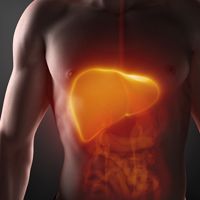Liver Injury to Leaky Gut
Non-alcoholic steatohepatitis (NASH), deemed a more serious form of non-alcoholic fatty liver disease (NAFLD) that can develop into liver fibrosis and cirrhosis, has been linked to the liver cancer-spiraling leaky intestinal wall, according to research in Cellular and Molecular Gastroenterology and Hepatology.

Non-alcoholic steatohepatitis (NASH), deemed a more serious form of non-alcoholic fatty liver disease (NAFLD) that can develop into liver fibrosis and cirrhosis, has been linked to the liver cancer-spiraling leaky intestinal wall, according to research in Cellular and Molecular Gastroenterology and Hepatology.
NASH and NAFLD’s association with obesity and diabetes has long spurred concern over the near epidemic status for both conditions in the US.
Jay Luther, MD, Massachusetts General Hospital, said, “Our study strengthens the clinical association between intestinal permeability and NASH, although we were unable to identify a mechanism.”
Researchers conducted a meta-analysis examining NASH patients using an animal model, which allowed them to disregard possible confounders of the clinical data, like antibiotic exposure and medical comorbidities.
Results indicated NASH patients were more likely to see increased “intestinal permeability” compared with healthy controls. Evidence suggested that bacteria and bacterial products from the gut travel directly into the bloodstream, undoubtedly worsening liver disease.
The data also underscored the significant role communication between the intestine and liver, the so-called gut-liver axis, plays in NASH development. Results also suggested that issuing an early phase of hepatic injury and inflammation would trigger altered intestinal permeability independent of TNFα and MLCK.
Researchers do understand; however, further research is necessary to navigate the steadily increasing evidence supporting gut-liver cross-talk.
Suraj J. Patel, MD, PhD, and Raymond Chung, MD, remarked, “We are hopeful that our findings add enthusiasm to the investigative efforts examining the liver-gut axis.”
“Hepatologists are currently ill-equipped at identifying the patients who are most likely to develop NASH. This is a pressing clinical challenge, as these patients are at greater risk for liver-related adverse events.This well-designed study enhances our understanding of the pathophysiology of NASH, which is critical to help identify high-risk NAFLD patients and therapeutic targets,” commented Rebecca G. Wells, MD, associate editor, Cellular and Molecular Gastroenterology and Hepatology.